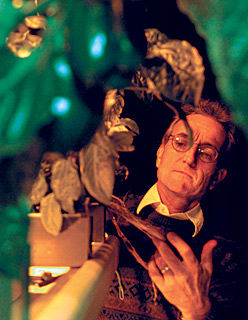 |
|
KEVIN B. KLAUS/Arizona Daily Wildcat
|
Gene Giacomelli, a professor and director of the UA Controlled Environment Agriculture Center, observes a bell pepper that was grown in a hydroponic system to be used in a food growth chamber for the South Pole.
|
|
|
By Jessica Lee
Arizona Daily Wildcat
Thursday, February 5, 2004
Print this
Scientific team in Antarctica to grow fresh food
In a frozen land where the sun doesn't shine from March to July, scientists who endure the South Pole's harsh winters at the Amundsen-Scott Research Station crave a supply of something crunchy and fresh.
Arriving in Antarctica this week after traveling nearly 10,000 miles, a UA-built "greenhouse" will soon be quenching the scientists' desire for romaine lettuce, cucumbers, herbs, and sweet and hot peppers.
Waking in the subzero, pitch-black mornings, the first things on researchers' minds are their stomachs.
"I've been told that the most important thing when the South Pole Station personnel wake up is, 'What's for breakfast?'" said Gene Giacomelli, agriculture and biosystems engineering professor and director of the UA Controlled Environment Agriculture Center.
Giacomelli helped design and manage the project.
But the apparatus isn't technically a greenhouse, as it uses no sunlight. Instead, artificial light is used to grow food in a growth chamber.
Fully enclosed, the food growth chamber is approximately 10 feet by 30 feet. About two-thirds of the chamber will be used for the crops, while the other one-third will welcome people to sit and absorb the artificial light for psychological benefits.
Funded by a $450,000 grant from the National Science Foundation, the chamber is unique in several respects.
All of the plants are grown in a hydroponic environment, a system where plants live solely in trays filled with water, rather than soil. Nutrients, similar to household Miracle-Gro, are placed directly in the water that is recycled over and over through the system of trays.
The apparatus provides the plants with the carbon dioxide and light they need to survive.
The carbon dioxide is shipped to the station as compressed gas and then pumped into the chamber.
 |
We were eating lots of meat and potatoes; everyone was looking for salads. ö Phil Sadler
Sadler Machine Company
|
 |
A unique lighting system was designed in which 12 1000-watt high-pressure sodium lamps are used to completely light the chamber.
Since light bulbs become hot over time, each bulb is placed in a system of water jackets, where water runs around the light fixtures and acts as a cooling agent.
The cooler temperature allows the plants to be placed closer to the lights without getting scorched.
Phil Sadler, of Sadler Machine Company, designed the water-cooled lamps. Sadler has spent 13 summer seasons in Antarctica. His first stint "on the ice" was in 1978 when there wasn't a greenhouse on the continent.
"We were eating lots of meat and potatoes; everyone was looking for salads. Every couple of weeks, we would get salad delivered, and everyone would chomp down," Sadler said.
The new, larger growth chamber will replace the original greenhouse built by Sadler.
But for eight months, during the southern hemisphere winter, the South Pole station cannot receive deliveries because of severe weather conditions. With that in mind, the food growth chamber was constructed so the crew could easily manage it.
"We designed it to be user friendly with friendly maintenance," Giacomelli said.
Part of the UA's commitment to the National Science Foundation is to provide educational training to the South Pole station occupants for a year and a half.
There will a webcam set up so Giacomelli and other faculty can aid the South Pole team when the plants are ailing.
Starting next fall, Giacomelli hopes to integrate the Internet educational experience with his UA students.
"I plan to lecture with the students and them (South Pole station team)," Giacomelli said.
Because of contamination concerns, the Antarctic Treaty states that soil, animal or plants are not allowed onto the southern ice, meaning the vegetables can only be delivered as tiny seeds.
"From the day the seeds are started, it will take about 100 days to get the first tomato," Giacomelli said. A head of lettuce would take about 30 days before it could be harvested.
"The exciting thing was I had an opportunity to learn how to create a hospitable environment for both humans and plants in the most inhospitable place in the world," said Lane Patterson, an agriculture and biosystems engineering senior who has worked on the project for two years.
The ability to grow food in extreme places, such as the South Pole, will play an important role in human space exploration. President Bush, in a recent NASA address, proposed sending humans to Mars in the future.
Researchers, including those at the UA, are currently working on designs for a Martian food growth chamber.
